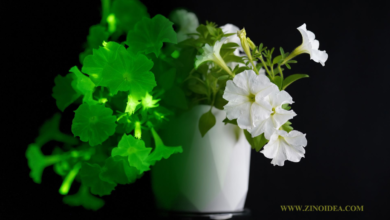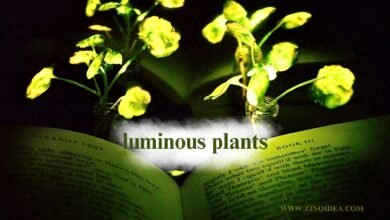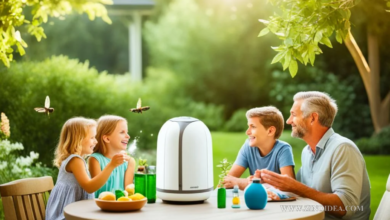Start Composting: Easy Guide for Beginners

Are you curious about composting but don’t know where to start? Composting turns food scraps and yard waste into nutrient-rich soil for your garden. It’s a simple way to make your garden thrive. Let’s explore how you can start composting today.
Key Takeaways
- Composting is a natural process that turns organic waste into nutrient-rich soil amendment.
- Composting offers numerous benefits, including reducing landfill waste, improving soil quality, and promoting plant growth.
- There are various composting methods to choose from, depending on your space, needs, and preferences.
- Proper selection and layering of composting materials are key to achieving a balanced, thriving compost pile.
- Maintaining moisture levels and troubleshooting common issues can help ensure a successful composting journey.
What is Composting?
Composting turns food scraps and yard waste into a nutrient-rich soil amendment. This happens through a natural process. It’s powered by microorganisms like bacteria and fungi. They eat the organic matter and turn it into a resource for gardeners.
Understanding the Composting Process
The composting process has several steps:
- Collection of organic materials: This includes food scraps, yard trimmings, and other biodegradable items.
- Aeration: Turning or mixing the materials in the compost bin or pile lets oxygen in. This is key for microorganisms to work well.
- Microbial decomposition: Microorganisms break down the organic matter. They release nutrients and create heat during this process.
- Maturation: As compost matures, it turns darker and becomes more uniform in texture. This shows the decomposition is done.
Benefits of Composting
Composting has many benefits for the environment and your garden:
- Improved soil quality: Compost adds organic matter and nutrients to the soil. This makes the soil better at holding water and supporting plant growth.
- Waste reduction: Composting recycles organic materials. This reduces waste sent to landfills and lowers the environmental impact of waste disposal.
- Sustainable gardening: Compost is a natural and renewable soil amendment. It helps plants grow and supports a healthy garden.
“Composting is one of the easiest and most rewarding ways to reduce waste and create a valuable resource for your garden.”
Choosing the Right Composting Method
There are many ways to compost, each fitting different needs and likes. You can pick between outdoor bins and indoor containers. Knowing the good and bad of each can help you pick the best for your garden or eco-friendly goals.
Outdoor Composting Bins
Outdoor bins are great for those with lots of yard space. They’re strong and help break down organic stuff into rich compost for your garden. They can hold a lot of material and get help from the sun and rain to compost faster.
Indoor Composting Containers
If you’re short on outdoor space or like a tidy setup, indoor containers are a good choice. They’re small and fit well in kitchens or utility rooms, perfect for city folks or small gardeners. These bins have special parts like filters or air systems to keep smells down and help things break down right.
Choosing between outdoor bins and indoor containers depends on your space, what you like, and your composting needs. Think about the pros and cons of each to make a smart choice and start composting well.

| Outdoor Composting Bins | Indoor Composting Containers |
|---|---|
| Larger capacity for more material | Compact and space-saving design |
| Exposure to natural elements | Odor control and contained system |
| Suitable for larger yards or gardens | Convenient for apartment or urban living |
Composting Materials
Starting a compost pile needs the right mix of organic stuff. You need both “green” (nitrogen-rich) and “brown” (carbon-rich) materials. Knowing what to add and avoid helps make a great compost for your garden.
What to Compost
- Green Materials: These include things like fruit and veggie scraps, grass clippings, coffee grounds, and eggshells.
- Brown Materials: These are things like dry leaves, shredded paper, cardboard, and sawdust.
- Manure from herbivorous animals, like cows, horses, or rabbits, is also good for your compost bin.
What Not to Compost
- Don’t compost meat, fish, oils, or dairy as they draw pests and smell bad.
- Leave out pet waste as it can have harmful bacteria.
- Big woody stuff like branches and stumps should be chopped or shredded before adding.
Picking the right composting materials makes a good base for your compost. It helps with the natural breakdown process.
“Composting is not only good for the environment, but it can also save you money by reducing waste and providing nutrient-rich soil for your garden.”
Setting Up Your Compost Bin
Choosing your composting method is the first step. Then, set up your compost bin by picking the right spot and getting it ready. This ensures your organic waste turns into rich compost.
Selecting the Ideal Location
Where you put your compost bin is key to composting success. Think about these things when picking a spot:
- Accessibility: Choose a spot you can easily get to. This lets you add materials and check on it often.
- Shade: Go for a spot that’s partly shaded. This keeps the compost at the right temperature. Don’t put it in direct sunlight, as it can dry it out.
- Drainage: Make sure the area drains well. This stops water from building up and causing bad smells and harmful conditions.
- Proximity: Put the compost bin close to your garden or yard. This makes it easy to move the finished compost to your plants.
Preparing the Bin
After finding the perfect spot, get your compost bin ready. Here’s what to do:
- Clean the bin: Clean the inside well, getting rid of any old debris.
- Add a base layer: Put a 4-6 inch layer of coarse stuff like sticks or twigs at the bottom. This helps with airflow and drainage.
- Introduce moisture: Spray the base layer with a little water to keep it moist, just right for composting.
- Add your first layer of organic matter: Start your compost pile with a mix of green and brown materials, in the right amounts.
With the right spot and a ready compost bin, you’re set to start composting. Next, we’ll cover how to begin and keep your bin in good shape.

How to Start Composting
Are you ready to start composting? This guide will show you how to layer your compost and keep the right moisture levels in compost. These steps are key for a successful composting journey.
Layering Techniques
Effective composting layering means mixing carbon-rich (brown) and nitrogen-rich (green) materials. Begin with a 3-inch layer of brown materials like dry leaves or shredded paper at the bottom. Next, add a 1-inch layer of green materials, such as fruit scraps or coffee grounds.
Keep alternating these layers. Make sure the pile stays moist but not too wet.
Maintaining Moisture Levels
Keeping the right moisture levels in compost is vital. Aim for a damp sponge consistency, with moisture between 40-60%. To keep it right, sprinkle water lightly as you build your pile.
Avoid letting it get too dry or too wet. This can harm the microorganisms that break down the materials.

“Composting is a simple and rewarding way to turn your organic waste into nutrient-rich soil for your garden.”
Follow these how to start composting tips to create a great compost pile. It will give you valuable fertilizer for your plants. Remember, patience and attention to detail are crucial for composting layering and keeping the right moisture levels in compost.
Troubleshooting Common Composting Issues
Even the most experienced composters sometimes face problems. Issues like bad smells and pests can upset the balance of your compost. But don’t worry, you can fix these problems with the right methods.
Odor Control
Bad smells from your compost bin mean something’s wrong. These smells usually come from an imbalance in the carbon-to-nitrogen ratio or too much moisture. Here’s how to reduce odors:
- Add more carbon-rich materials, like dried leaves, shredded paper, or straw, to balance out the nitrogen-heavy ingredients.
- Make sure your compost has good airflow by stirring it often or adding more air holes to your bin.
- Check the moisture level by adding dry materials or turning the pile to help it drain better.
Pest Management
Pests, such as rodents, insects, or bigger animals, can be a problem when composting. Here are ways to keep them away:
- Use a compost bin that’s designed to keep out rodents or build a wire mesh enclosure around your pile.
- Don’t put meat, dairy, or other pest-attracting foods in your compost. Cover food waste with carbon-rich materials instead.
- Turn and aerate your compost often to stop insects from breeding.
By solving these common composting issues, like odor control and pest management, you can keep your compost healthy. This way, you can enjoy all the benefits of composting.

Composting Tips for Beginners
Starting to compost can be exciting and a bit overwhelming for beginners. We’ve put together a list of composting tips for beginners to help you start right. These tips will make your composting journey successful and rewarding.
Start Small and Experiment
Begin with a small setup, like a bin or tumbler, for composting. This lets you learn the ropes and adjust as you go. Try different materials and methods to see what suits you best.
Maintain the Right Balance
- Keep your compost pile balanced with green (nitrogen-rich) and brown (carbon-rich) materials.
- Check the moisture, making sure it’s damp but not too wet.
- Turn or mix your compost often to keep it aerated and help it break down.
Patience is Key
Composting is a slow process. Don’t rush it, as this can lead to bad smells or incomplete breakdown. Trust the process and watch as your waste turns into rich soil.
Embrace Variety
Try using a mix of composting materials, like food scraps, paper, and coffee grounds. This mix creates a balanced compost that’s good for your garden or houseplants.
“Composting is not only good for the environment, but it’s also a rewarding hobby that can teach you a lot about the natural world.”
Follow these composting tips for beginners to create a great compost system. It will benefit your garden and the planet. Happy composting!
Using Your Finished Compost
Once your compost is ready, you can use it in your garden or find other uses for it. This guide will show you how to add it to your soil and suggest other ways to use it.
Incorporating Compost into Your Garden
Mixing your finished compost into your garden soil is a great way to make it better. Add the compost to the top layer of your soil and spread it out evenly. This will make your soil richer, help it hold moisture better, and make it more fertile. Your plants will grow healthier because of it.
Other Uses for Compost
Compost isn’t just for your garden. You can also use it in potting mixes, on your lawn, or to make a compost tea for your houseplants. If you have extra, consider giving it to friends, family, or local gardens. Sharing compost helps spread the word about sustainable gardening.
FAQ
What is composting?
Composting turns food scraps and yard waste into a nutrient-rich soil amendment called compost. It’s a natural process.
What are the benefits of composting?
Composting boosts soil quality, cuts waste, helps gardens thrive, and supports sustainability.
What are the different composting methods?
You can compost outdoors with bins or indoors with containers. The choice depends on your space and preferences.
What materials can I compost?
You can compost food scraps, yard waste, and other biodegradable items. Mix “green” (nitrogen-rich) and “brown” (carbon-rich) materials for balance.
How do I set up a compost bin?
Pick the right spot and prepare your bin well for successful composting.
How do I start the composting process?
Start by layering materials correctly and keeping your pile moist.
How do I troubleshoot common composting issues?
Use solutions to fix odors and pests and keep your compost healthy.
What tips can you provide for beginner composters?
Beginners can improve their composting with tips and advice for better results.
How can I use my finished compost?
Use mature compost to enrich your garden soil or find other uses for its nutrients.



